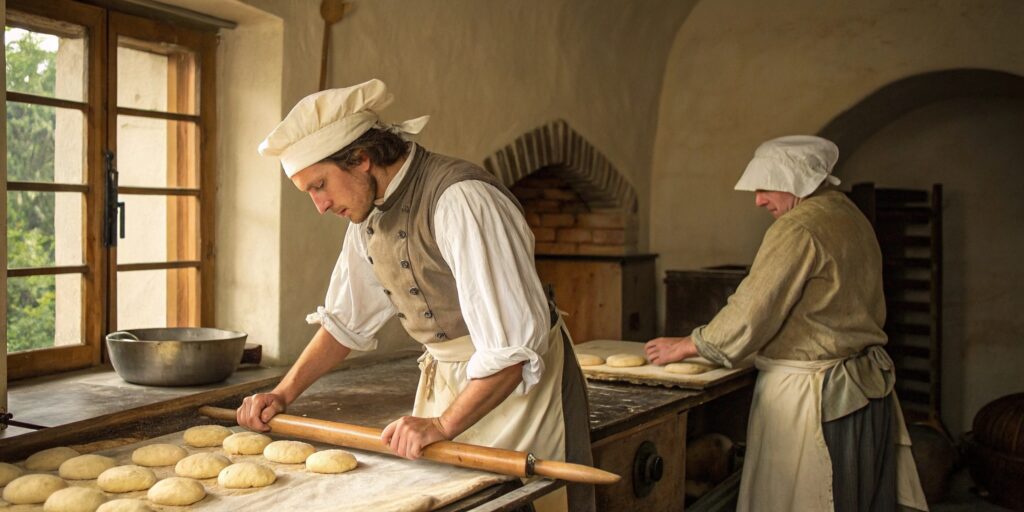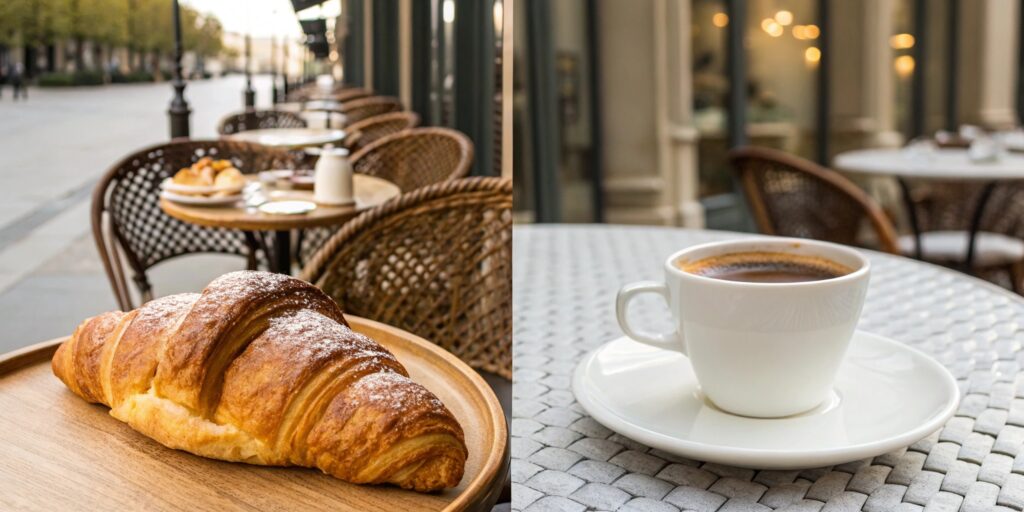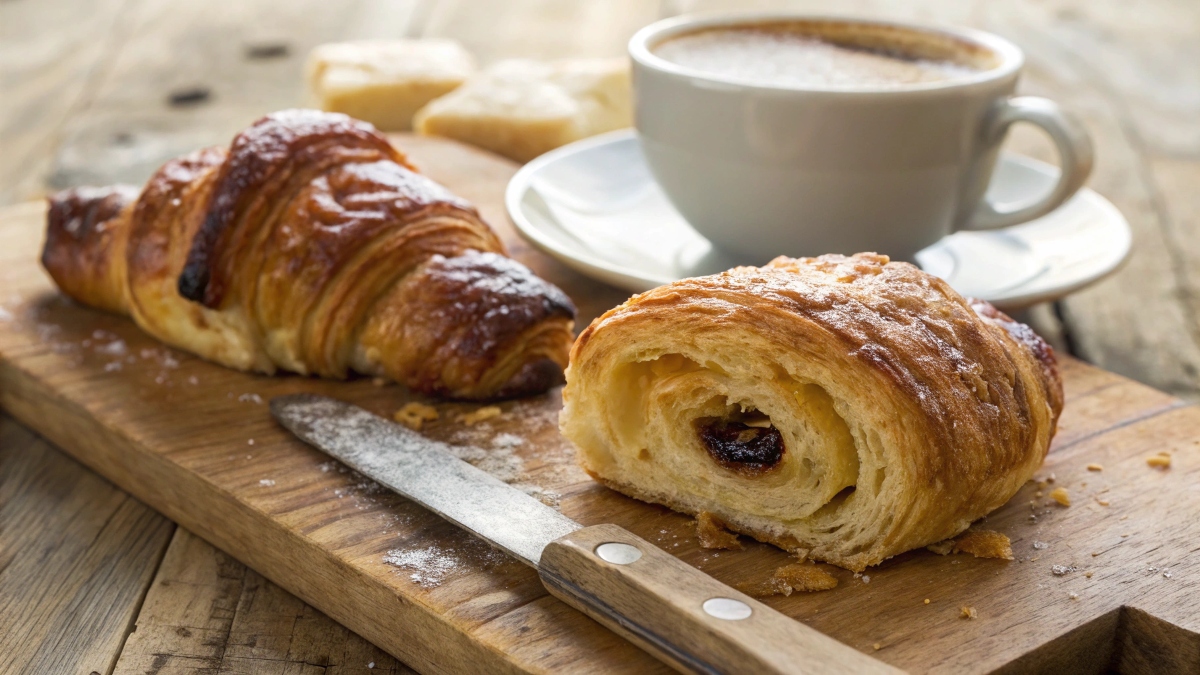Both the croissant and the Gipfeli are beloved pastries enjoyed across Europe. At first glance, they may seem quite similar; however, they have distinct differences in ingredients, preparation, texture, and cultural significance. So, what truly sets them apart? In this article, we will thoroughly explore the key differences between a croissant and a Gipfeli, uncovering their unique characteristics and historical origins.
The Origins of Croissants and Gipfeli

To fully understand what makes a croissant different from a Gipfeli, we need to take a step back in time. While the croissant is famously associated with France, its true roots, interestingly enough, lie in Austria. Meanwhile, the Gipfeli is a Swiss adaptation of this popular European pastry.
Where Did Croissants Originate? 🇫🇷
The origins of the croissant can be traced back to the 17th century in Austria. At that time, the kipferl, a crescent-shaped bread roll, was widely enjoyed in Viennese bakeries. However, it wasn’t until the early 19th century that the French adopted this pastry, refining it into the rich, buttery, and flaky croissant we recognize today.
The Swiss Connection: Gipfeli’s Background 🇨🇭
In contrast, the Gipfeli emerged in Switzerland as a simpler and less buttery alternative to the croissant. Unlike its French cousin, the Swiss Gipfeli is generally firmer, significantly less flaky, and has a more subtle flavor. Additionally, it is an essential part of Swiss breakfast culture, often enjoyed with butter, jam, or honey.
Key Differences Between a Croissant and a Gipfeli
Although both pastries share a similar crescent-like appearance, they differ in several ways, particularly in terms of ingredients, texture, and baking techniques.
Dough Composition and Ingredients
The most notable difference lies in the dough itself. French croissants are prepared using a butter-laminated dough, which requires folding layers of butter between layers of dough multiple times. As a result, this method creates the signature flaky texture. On the other hand, Gipfeli dough contains significantly less butter and has a denser, more bread-like consistency.
Butter Content & Lamination Process
Another key distinction is the butter content. Since croissants have a higher butter ratio, they achieve a light, airy texture. This is due to the layering process during lamination, which results in the crispy and flaky layers. Conversely, Gipfeli contain far less butter, making them noticeably denser and drier in comparison.
The Baking Process: What Sets Them Apart?
Moreover, the baking process plays a crucial role in differentiating the two pastries. Croissants require precise lamination and are typically baked at a higher temperature, leading to a crisp outer layer. Meanwhile, Gipfeli are baked using a more straightforward dough, resulting in a uniform texture with a slightly chewier bite.
Shape and Appearance: Can You Spot the Difference? 👀
Although both pastries share a similar crescent-like appearance, their shapes and textures are quite distinct.
Classic French Croissant Shape
Croissants are typically larger and exhibit a crescent shape with clearly visible laminated layers. Their exterior is golden brown and incredibly crispy, with a noticeable rise due to the airy structure of the dough.
The Unique Form of a Swiss Gipfeli
By comparison, Gipfeli are usually more compact, with a firmer structure. Additionally, they are often slightly smaller than croissants and have a denser interior. Unlike croissants, their texture remains more uniform, with fewer visible layers.
Texture & Mouthfeel: Which One is Crispier? 🥐
One of the most noticeable differences between a croissant and a Gipfeli is how they feel when you take a bite. Not only does the texture set them apart, but it is also influenced by several factors, including ingredients, butter content, and baking methods.
How a Croissant Feels When You Bite Into It
French croissants have an unmistakable crispiness the moment you bite into them. Because of their laminated dough, they produce a delicate crunch on the outside while remaining incredibly light and airy inside. Moreover, the layers of butter melt effortlessly in your mouth, leaving behind a rich and flaky texture.
What Makes a Gipfeli Different in Texture?
On the other hand, Gipfeli are noticeably denser and far less flaky. Since they lack the extensive lamination process that makes croissants so airy, they have a slightly chewy texture with a firmer crust. Unlike croissants, they do not shatter into delicate flakes when eaten, making them a tidier option for on-the-go breakfasts.
Taste & Flavor Profiles: Which One is Richer?
Beyond texture, croissants and Gipfeli also differ significantly in taste. While both have a subtle sweetness, the variations in butter and sugar content influence their overall flavor profile.
The Buttery Goodness of a Croissant
French croissants are renowned for their rich, buttery, and slightly sweet flavor. The generous use of butter enhances their taste, making them an indulgent treat. Consequently, croissants are often enjoyed plain or with simple spreads such as jam or honey to complement their richness.
Gipfeli’s Subtler Flavor and Less Butter
By comparison, Gipfeli have a far more neutral flavor. Since they contain less butter, they tend to be drier and slightly bread-like. Even though they are still enjoyable, their taste is noticeably less decadent than croissants, making them a lighter and more understated breakfast choice.
Culinary Uses & How They Are Enjoyed
Both croissants and Gipfeli are undeniably delicious on their own. However, they are often paired with different accompaniments depending on the cultural context.
Classic Croissant Pairings
In France, croissants are typically served with coffee or tea. Additionally, they are commonly paired with butter, fruit preserves, or even chocolate. Some variations include almond croissants, which are filled with almond paste and topped with sliced almonds, adding a delightful nutty crunch.
How the Swiss Enjoy Their Gipfeli
Meanwhile, in Switzerland, Gipfeli are a staple of the traditional breakfast experience. More often than not, they are enjoyed with butter and jam or dipped into coffee. Unlike croissants, they are rarely filled with chocolate or almond paste, keeping their flavor profile simple and understated.
Nutritional Differences: Which One is Healthier? 🤔
For those mindful of their diet, understanding the nutritional differences between a croissant and a Gipfeli can help in making a more informed choice.
Calorie & Fat Comparison
Since croissants contain layers of rich butter, they tend to have a higher calorie and fat content. On average, a butter croissant provides approximately 230-270 calories and 12-15 grams of fat. In contrast, a Gipfeli typically contains 180-220 calories and 7-10 grams of fat, making it a slightly lighter alternative.
Are Croissants and Gipfeli Vegan-Friendly?
Traditionally, both croissants and Gipfeli contain dairy, making them unsuitable for vegans. Nevertheless, many bakeries now offer vegan croissants and vegan Gipfeli made with plant-based butter or margarine. These alternatives successfully replicate the texture and flavor while remaining completely dairy-free.
Croissant vs. Gipfeli: Variations Around the World 🌍
Both croissants and Gipfeli have inspired variations in different cultures. While the French croissant remains an iconic pastry worldwide, the Swiss Gipfeli has also evolved in unique ways.
French Croissant Variations 🥐
France has mastered the art of pastry-making, leading to numerous croissant-based creations:
- Almond Croissant: A croissant filled with almond paste and topped with sliced almonds.
- Pain au Chocolat: Also known as a “chocolate croissant,” this pastry features layers of dough with a melted chocolate center.
- Cheese or Ham Croissants: Savory versions filled with cheese, ham, or béchamel sauce.
For those interested in unique pastries, you may also like What is a Mandelgipfel?, a delicious Swiss variation made with almonds.
Gipfeli Variations in Switzerland 🇨🇭
Swiss bakeries offer different types of Gipfeli:
- Butter Gipfeli: A slightly richer, butter-infused version of the classic Gipfeli.
- Mandelgipfel: A variation with almond paste and a sugar glaze.
- Whole Wheat Gipfeli: A healthier version made with whole wheat flour.
Which One is More Popular? 📊
The croissant and Gipfeli each have loyal followings. But which one is more widely consumed?
Are Croissants More Well-Known Internationally? 🇫🇷
Croissants are a staple in French bakeries and are widely recognized across Europe, North America, and even parts of Asia. Their rich flavor, flaky texture, and versatility make them a preferred choice in many cafes worldwide.
Gipfeli’s Popularity in Switzerland 🇨🇭
In Switzerland, Gipfeli are deeply embedded in local culture. They are often the go-to pastry for breakfast, commonly found in Swiss bakeries, hotels, and home kitchens. Unlike croissants, they are usually eaten plain or with minimal toppings.
Cultural Symbolism: Croissant vs. Gipfeli 🏛️

Both pastries carry cultural significance in their respective countries.
Why is the Croissant a Symbol of France? 🇫🇷
Even though croissants originated from Austria, they became a symbol of French culinary excellence. Today, they are synonymous with Parisian cafés, often enjoyed with coffee and fresh juice in the morning.
Gipfeli’s Role in Swiss Breakfast Culture 🇨🇭
Gipfeli, while not as internationally famous, are just as integral to Swiss culture. They are a common choice for breakfast alongside coffee, butter, and jam. Unlike croissants, they are often paired with more substantial meals.
Which One Should You Try? 🤔
Choosing between a croissant and a Gipfeli depends on your personal preference.
When to Choose a Croissant
- If you love buttery, flaky pastries.
- If you want a more indulgent breakfast treat.
- If you enjoy variations like almond or chocolate croissants.
Why a Gipfeli Might Be a Better Choice
- If you prefer a denser, less buttery texture.
- If you like a slightly healthier alternative to croissants.
- If you want a simpler, everyday breakfast pastry.
Want to try making your own? Check out this Gipfeli Recipe and enjoy fresh Swiss pastries at home!
Final Thoughts: Croissant vs. Gipfeli
Both the croissant and the Gipfeli have their place in European cuisine. While croissants are known for their buttery, flaky layers, Gipfeli offer a firmer, less rich alternative. Whether you prefer the indulgence of a croissant or the simplicity of a Gipfeli, both pastries are delicious in their own way.

